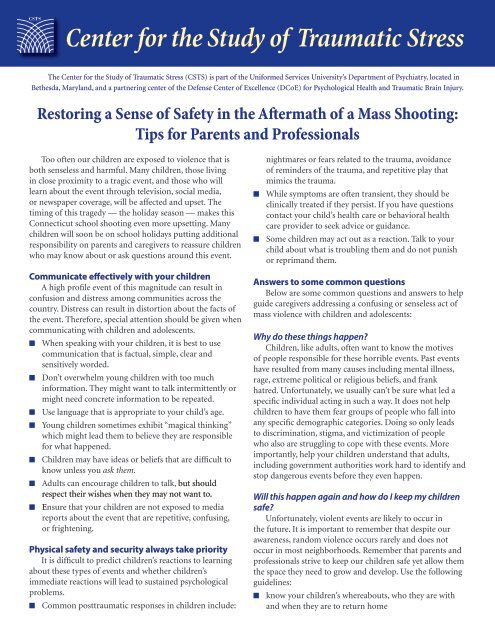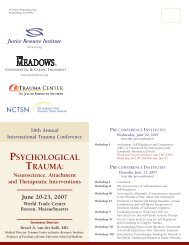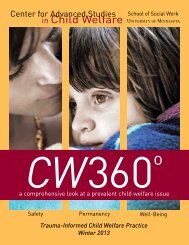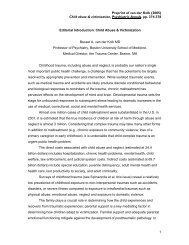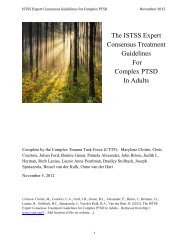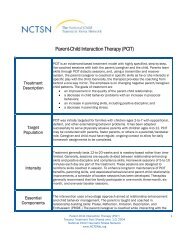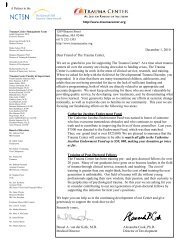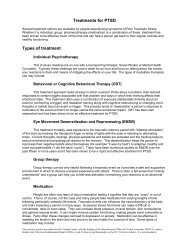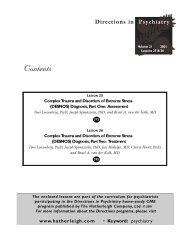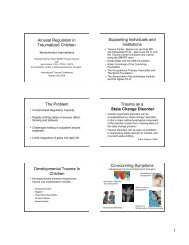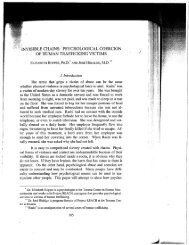Restoring a Sense of Safety - Center for the Study of Traumatic Stress
Restoring a Sense of Safety - Center for the Study of Traumatic Stress
Restoring a Sense of Safety - Center for the Study of Traumatic Stress
Create successful ePaper yourself
Turn your PDF publications into a flip-book with our unique Google optimized e-Paper software.
<strong>Center</strong> <strong>for</strong> <strong>the</strong> <strong>Study</strong> <strong>of</strong> <strong>Traumatic</strong> <strong>Stress</strong><br />
The <strong>Center</strong> <strong>for</strong> <strong>the</strong> <strong>Study</strong> <strong>of</strong> <strong>Traumatic</strong> <strong>Stress</strong> (CSTS) is part <strong>of</strong> <strong>the</strong> Uni<strong>for</strong>med Services University’s Department <strong>of</strong> Psychiatry, located in<br />
Be<strong>the</strong>sda, Maryland, and a partnering center <strong>of</strong> <strong>the</strong> Defense <strong>Center</strong> <strong>of</strong> Excellence (DCoE) <strong>for</strong> Psychological Health and <strong>Traumatic</strong> Brain Injury.<br />
<strong>Restoring</strong> a <strong>Sense</strong> <strong>of</strong> <strong>Safety</strong> in <strong>the</strong> Aftermath <strong>of</strong> a Mass Shooting:<br />
Tips <strong>for</strong> Parents and Pr<strong>of</strong>essionals<br />
Too <strong>of</strong>ten our children are exposed to violence that is<br />
both senseless and harmful. Many children, those living<br />
in close proximity to a tragic event, and those who will<br />
learn about <strong>the</strong> event through television, social media,<br />
or newspaper coverage, will be affected and upset. The<br />
timing <strong>of</strong> this tragedy — <strong>the</strong> holiday season — makes this<br />
Connecticut school shooting even more upsetting. Many<br />
children will soon be on school holidays putting additional<br />
responsibility on parents and caregivers to reassure children<br />
who may know about or ask questions around this event.<br />
Communicate effectively with your children<br />
A high pr<strong>of</strong>ile event <strong>of</strong> this magnitude can result in<br />
confusion and distress among communities across <strong>the</strong><br />
country. Distress can result in distortion about <strong>the</strong> facts <strong>of</strong><br />
<strong>the</strong> event. There<strong>for</strong>e, special attention should be given when<br />
communicating with children and adolescents.<br />
■■<br />
■■<br />
■■<br />
■■<br />
■■<br />
■■<br />
■■<br />
When speaking with your children, it is best to use<br />
communication that is factual, simple, clear and<br />
sensitively worded.<br />
Don’t overwhelm young children with too much<br />
in<strong>for</strong>mation. They might want to talk intermittently or<br />
might need concrete in<strong>for</strong>mation to be repeated.<br />
Use language that is appropriate to your child’s age.<br />
Young children sometimes exhibit “magical thinking”<br />
which might lead <strong>the</strong>m to believe <strong>the</strong>y are responsible<br />
<strong>for</strong> what happened.<br />
Children may have ideas or beliefs that are difficult to<br />
know unless you ask <strong>the</strong>m.<br />
Adults can encourage children to talk, but should<br />
respect <strong>the</strong>ir wishes when <strong>the</strong>y may not want to.<br />
Ensure that your children are not exposed to media<br />
reports about <strong>the</strong> event that are repetitive, confusing,<br />
or frightening.<br />
Physical safety and security always take priority<br />
It is difficult to predict children’s reactions to learning<br />
about <strong>the</strong>se types <strong>of</strong> events and whe<strong>the</strong>r children’s<br />
immediate reactions will lead to sustained psychological<br />
problems.<br />
■■<br />
Common posttraumatic responses in children include:<br />
■■<br />
■■<br />
nightmares or fears related to <strong>the</strong> trauma, avoidance<br />
<strong>of</strong> reminders <strong>of</strong> <strong>the</strong> trauma, and repetitive play that<br />
mimics <strong>the</strong> trauma.<br />
While symptoms are <strong>of</strong>ten transient, <strong>the</strong>y should be<br />
clinically treated if <strong>the</strong>y persist. If you have questions<br />
contact your child’s health care or behavioral health<br />
care provider to seek advice or guidance.<br />
Some children may act out as a reaction. Talk to your<br />
child about what is troubling <strong>the</strong>m and do not punish<br />
or reprimand <strong>the</strong>m.<br />
Answers to some common questions<br />
Below are some common questions and answers to help<br />
guide caregivers addressing a confusing or senseless act <strong>of</strong><br />
mass violence with children and adolescents:<br />
Why do <strong>the</strong>se things happen<br />
Children, like adults, <strong>of</strong>ten want to know <strong>the</strong> motives<br />
<strong>of</strong> people responsible <strong>for</strong> <strong>the</strong>se horrible events. Past events<br />
have resulted from many causes including mental illness,<br />
rage, extreme political or religious beliefs, and frank<br />
hatred. Un<strong>for</strong>tunately, we usually can’t be sure what led a<br />
specific individual acting in such a way. It does not help<br />
children to have <strong>the</strong>m fear groups <strong>of</strong> people who fall into<br />
any specific demographic categories. Doing so only leads<br />
to discrimination, stigma, and victimization <strong>of</strong> people<br />
who also are struggling to cope with <strong>the</strong>se events. More<br />
importantly, help your children understand that adults,<br />
including government authorities work hard to identify and<br />
stop dangerous events be<strong>for</strong>e <strong>the</strong>y even happen.<br />
Will this happen again and how do I keep my children<br />
safe<br />
Un<strong>for</strong>tunately, violent events are likely to occur in<br />
<strong>the</strong> future. It is important to remember that despite our<br />
awareness, random violence occurs rarely and does not<br />
occur in most neighborhoods. Remember that parents and<br />
pr<strong>of</strong>essionals strive to keep our children safe yet allow <strong>the</strong>m<br />
<strong>the</strong> space <strong>the</strong>y need to grow and develop. Use <strong>the</strong> following<br />
guidelines:<br />
■■<br />
know your children’s whereabouts, who <strong>the</strong>y are with<br />
and when <strong>the</strong>y are to return home
■■<br />
■■<br />
■■<br />
■■<br />
■■<br />
■■<br />
set clear and consistent curfews<br />
have a clear method <strong>of</strong> communication in normal and<br />
emergency situations (e.g. cell phone)<br />
educate <strong>the</strong>m about places or situations that are more<br />
likely to put <strong>the</strong>m in danger and teach <strong>the</strong>m to<br />
avoid high-risk exposures<br />
monitor federal and local advise about risks that might<br />
surface<br />
be vigilant about safety in your community<br />
strive to keep open communication with children and<br />
adolescents<br />
How does one plan <strong>for</strong> this type <strong>of</strong> emergency<br />
Discuss hypo<strong>the</strong>tical emergency situations with your<br />
children and calmly talk with <strong>the</strong>m about what <strong>the</strong>y can<br />
do to keep <strong>the</strong>mselves safe when danger presents itself.<br />
Instruct <strong>the</strong>m to trust and seek help from police and o<strong>the</strong>r<br />
authorities who are likely to be on <strong>the</strong> scene quickly. Always<br />
encourage your children to say something when <strong>the</strong>y see<br />
something suspicious. Establishing a communication plan<br />
<strong>for</strong> locating family members can help to reduce anxiety.<br />
Parents should know where <strong>the</strong>ir children are and children<br />
should tell parents when <strong>the</strong>y have changed <strong>the</strong>ir location.<br />
Is my child okay<br />
Children will show a wide variety <strong>of</strong> reactions. There<br />
is no “normal” reaction to stressful events. Some reactions<br />
include tearfulness, separation or bedtime anxiety, or<br />
regression in behaviors. More severe reactions may<br />
include reliving <strong>the</strong> trauma through dreams, emotional<br />
numbness, increased startle responses, withdrawal or<br />
physical symptoms like racing heartbeat, nausea or change<br />
in appetite.<br />
These types <strong>of</strong> events, while tragic, can sometimes lead<br />
to positive opportunities. They become opportunities to<br />
open, or reopen, channels <strong>of</strong> communication among family<br />
members. They may provide us opportunities to appreciate<br />
each o<strong>the</strong>r more and to express our love <strong>for</strong> one ano<strong>the</strong>r.<br />
They may provide opportunities <strong>for</strong> families to better plan<br />
how <strong>the</strong>y will cope with future difficult times or topics. It is<br />
important to focus on what might positively emerge from<br />
<strong>the</strong>se tragic events while we also acknowledge tragic losses.<br />
Online Resources<br />
If you have any questions about your child’s health or<br />
response to a traumatic event you can seek pr<strong>of</strong>essional<br />
advice from a community primary care or behavioral care<br />
provider or review additional resources at <strong>the</strong> following<br />
sites:<br />
<strong>Center</strong> <strong>for</strong> <strong>the</strong> <strong>Study</strong> <strong>of</strong> <strong>Traumatic</strong> <strong>Stress</strong><br />
National Child <strong>Traumatic</strong> <strong>Stress</strong> Network<br />
American Academy <strong>of</strong> Child and Adolescent Psychiatry<br />
American Academy <strong>of</strong> Pediatrics<br />
American Psychiatric Association<br />
American Psychological Association<br />
American Red Cross<br />
www.cstsonline.org<br />
www.ncstn.org<br />
www.aacap.org<br />
www.aap.org<br />
www.psych.org<br />
www.apa.org<br />
www.redcross.org<br />
<strong>Center</strong> <strong>for</strong> <strong>the</strong> <strong>Study</strong> <strong>of</strong> <strong>Traumatic</strong> <strong>Stress</strong><br />
Uni<strong>for</strong>med Services University <strong>of</strong> <strong>the</strong> Health Sciences<br />
4301 Jones Bridge Road, Be<strong>the</strong>sda, MD 20814-4799<br />
Tel: 301-295-2470 | Fax: 301-319-6965<br />
www.usuhs.mil/csts | www.CSTSonline.org<br />
A partnering center <strong>of</strong> <strong>the</strong> Defense <strong>Center</strong>s <strong>of</strong> Excellence <strong>for</strong> Psychological Health and <strong>Traumatic</strong> Brain Injury


